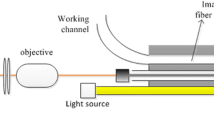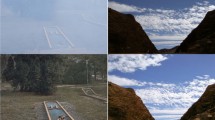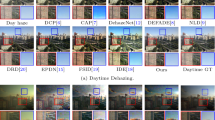Abstract
The visibility and analyzability of MRI and CT images have a great impact on the diagnosis of medical diseases. Therefore, for low-quality MRI and CT images, it is necessary to effectively improve the contrast while suppressing the noise. In this paper, we propose an enhancement and denoising strategy for low-quality medical images based on the sequence decomposition Retinex model and the inverse haze removal approach. To be specific, we first estimate the smoothed illumination and de-noised reflectance in a successive sequence. Then, we apply a color inversion from 0–255 to the estimated illumination, and introduce a haze removal approach based on the dark channel prior to adjust the inverted illumination. Finally, the enhanced image is generated by combining the adjusted illumination and the de-noised reflectance. As a result, improved visibility is obtained from the processed images and inefficient or excessive enhancement is avoided. To verify the reliability of the proposed method, we perform qualitative and quantitative evaluation on five MRI datasets and one CT dataset. Experimental results demonstrate that the proposed method strikes a splendid balance between enhancement and denoising, providing performance superior to that of several state-of-the-art methods.
Graphical abstract








Similar content being viewed by others
Explore related subjects
Discover the latest articles, news and stories from top researchers in related subjects.References
Liu SJ, Cao JX, Liu HQ et al (2017) MRI reconstruction using a joint constraint in patch-based total variational framework - ScienceDirect. J Vis Commun Image Represent 46:150–164
Ohlmeyer SM, Laun FB, Bickelhaupt SM et al (2021) Ultra-high b-value diffusion-weighted imaging-based abbreviated protocols for breast cancer detection. Invest Radiol 56(10):629–636
Huh YJ, Kim DH, Kim B et al (2021) Per-feature accuracy of liver imaging reporting and data system locoregional treatment response algorithm: a systematic review and meta-analysis. Cancers 13(17):4432
Panse V and Gupta R (2021) Medical image enhancement with brightness preserving based on local contrast stretching and global dynamic histogram equalization[C]. 2021 10th IEEE International Conference on Communication Systems and Network Technologies (CSNT), pp 164–170.
Maria HH, Jossy AM, Malarvizhi G et al (2021) Analysis of lifting scheme based Double Density Dual-Tree Complex Wavelet Transform for de-noising medical images. Optik 241:166883
Li M, Liu J, Yang W et al (2018) Structure-revealing low-light image enhancement via robust retinex model. IEEE Trans Image Process 27:2828–2841
Shangguan H, Zhang Q, Liu Y et al (2016) Low-dose CT statistical iterative reconstruction via modified MRF regularization. Comput Methods Programs Biomed 123:129–141
Wang J, Li T, Lu H et al (2006) Penalized weighted least-squares approach to sinogram noise reduction and image reconstruction for low-dose X-ray computed tomography. IEEE Trans Med Imaging 25(10):1272–1283
Chen QH, Yuan ZD, Zhou C et al (2020) Low-dose dental CT image enhancement using a multiscale feature sensing network. Nucl Instruments Meth Phys Res Sect A Acceler Spectrometer Detect Assoc Equip 981:164530
Panse V and Gupta R (2021) Medical image enhancement with brightness preserving based on local contrast stretching and global dynamic histogram equalization. 2021 10th IEEE International Conference on Communication Systems and Network Technologies (CSNT), pp. 64–170.
Sdiri B, Kaaniche M, Cheikh FA et al (2019) Efficient enhancement of stereo endoscopic images based on joint wavelet decomposition and binocular combination. IEEE Trans Medic Imag 38(1):33–45
Parihar A S, and Singh K (2018) A study on Retinex based method for image enhancement[C]. 2018 2nd International Conference on Inventive Systems and Control (ICISC), Coimbatore, pp. 619–624.
Land E (1997) The Retinex theory of color vision. Scientific American 237(6):108–128
Frankle J, Mccann J (1983) Method and apparatus for lightness imaging[P]. US, 4384336.
Wang W, Wu X, Yuan X et al (2020) An experiment-based review of low-light image enhancement methods. IEEE Access 99:1–1
Jobson DJ, Rahman Z, Woodell GA (1997) Properties and performance of a center/surround retinex. IEEE Trans Image Process 6:451–462
Rahman Z, Jobson DJ, Woodell GA (1996) Multi-scale retinex for color image enhancement. Proc 3rd IEEE Int Conf Imag Proc 3:1003–1006
Rahman ZU, Jobson DJ, Woodell GA (2004) Retinex processing for automatic image enhancement. Proc SPIE Int Soc Optical Eng 13:100–110
Wang LZ, Yao XT, Meng Z et al (2013) An optical coherence tomography attenuation compensation algorithm based on adaptive multi-scale Retinex. Chin J Laser 40(12):1204001
Parihar D A S and Singh K (2020) Illumination estimation for nature preserving low-light image enhancement
Kimmel R, Elad M, Shaked D et al (2003) A variational framework for Retinex. Int J Comput Vision 52(1):7–23
Wang S, Zheng J, Hu H et al (2013) Naturalness preserved enhancement algorithm for non-uniform illumination images. IEEE Trans Image Process 22:3538–3548
Fu X, Zeng D, Huang Y et al (2016) A fusion-based enhancing method for weakly illuminated images. Signal Process 129:82–96
Guo X, Li Y, Ling H (2017) Lime: Low-light image enhancement via illumination map estimation. IEEE Trans Image Process 26:982–993
Ng MK, Wang W (2011) A total variation model for Retinex. SIAM J Imag Sci 4:345–365
Fu X, Zeng D, Huang Y, et al. (2016) A weighted variational model for simultaneous reflectance and illumination estimation[C]. IEEE Conference on Computer Vision and Pattern Recognition (CVPR), Las Vegas, NV, pp. 2782–2790.
Li L, Wang R, Wang W et al (2015) A low-light image enhancement method for both denoising and contrast enlarging. IEEE Int Conf Imag Proc (ICIP) 2015:3730–3734
Zhang L, Shen P, Peng X et al (2016) Simultaneous enhancement and noise reduction of a single low-light image. IET Image Proc 10(11):840–847
Ren X T, Li M, Cheng W H, et al. (2018) Joint enhancement and denoising method via sequential decomposition[C]. The IEEE International Symposium on Circuits and Systems, pp 1–5.
Ren XT, Yang W, Cheng WH et al (2020) LR3M: robust low-light enhancement via low-rank regularized retinex model. IEEE Trans Image Process 29:5862–5876
Xuan Dong, et al (2011) Fast efficient algorithm for enhancement of low lighting video[C]. 2011 IEEE International Conference on Multimedia and Expo, Barcelona, pp 1–6.
Goldstein T, Osher S (2009) The split Bregman method for L1-regularized problems. SIAM J Imag Sci 2:323–343
Farbman Z, Fattal R, Lischinski D et al (2008) Edge-preserving decompositions for multi-scale tone and detail manipulation. ACM Trans Graphics 27(3):1–10
He K M, Sun J, and Tang X O (2009) Single image haze removal using dark channel prior[C]. 2009 IEEE Conference on Computer Vision and Pattern Recognition, Miami, pp 1956–1963.
Ying Z, Li G, and Gao W. A bio-inspired multi-exposure fusion framework for low-light image enhancement [CS]. 2017, arXiv:1711.00591.
Acknowledgements
The authors thank the editor and anonymous reviewers for their commons and suggestions on the manuscripts.
Funding
This work was supported by the National Natural Science Foundation of China (NNSFC) (grant nos. 11772081, 11972106).
Author information
Authors and Affiliations
Corresponding author
Additional information
Publisher’s Note
Springer Nature remains neutral with regard to jurisdictional claims in published maps and institutional affiliations.
Rights and permissions
About this article
Cite this article
Chen, L., Tang, C., Xu, M. et al. Enhancement and denoising method for low-quality MRI, CT images via the sequence decomposition Retinex model, and haze removal algorithm. Med Biol Eng Comput 59, 2433–2448 (2021). https://doi.org/10.1007/s11517-021-02451-6
Received:
Accepted:
Published:
Issue Date:
DOI: https://doi.org/10.1007/s11517-021-02451-6




